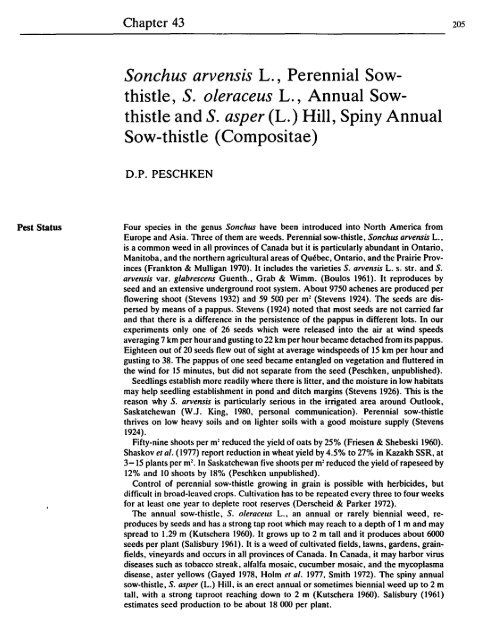pdf, 57.71Mb - Entomological Society of Canada
pdf, 57.71Mb - Entomological Society of Canada
pdf, 57.71Mb - Entomological Society of Canada
You also want an ePaper? Increase the reach of your titles
YUMPU automatically turns print PDFs into web optimized ePapers that Google loves.
Pest Status<br />
Chapter 43<br />
Sonchus arvensis L., Perennial Sowthistle,<br />
S. oleraceus L., Annual Sowthistle<br />
and S. asper (L.) Hill, Spiny Annual<br />
Sow-thistle (Compositae)<br />
D.P. PESCH KEN<br />
Four species in the genus Sonchlls have been introduced into North America from<br />
Europe and Asia. Three <strong>of</strong> them are weeds. Perennial sow-thistle. Sonchus arvensis L..<br />
is a common weed in all provinces <strong>of</strong> <strong>Canada</strong> but it is particularly abundant in Ontario.<br />
Manitoba. and the northern agricultural areas <strong>of</strong> Quebec. Ontario. and the Prairie Provinces<br />
(Frankton & Mulligan 1970). It includes the varieties S. arvensis L. s. str. and S.<br />
arvensis var. glabrescens Guenth .• Grab & Wimm. (Boulos 1961). It reproduces by<br />
seed and an extensive underground root system. About 9750 achenes are produced per<br />
flowering shoot (Stevens 1932) and 59500 per m 1 (Stevens 1924). The seeds are dispersed<br />
by means <strong>of</strong> a pappus. Stevens (1924) noted that most seeds are not carried far<br />
and that there is a difference in the persistence <strong>of</strong> the pappus in different lots. In our<br />
experiments only one <strong>of</strong> 26 seeds which were released into the air at wind speeds<br />
averaging 7 km per hour and gusting to 22 km per hour became detached from its pappus.<br />
Eighteen out <strong>of</strong> 20 seeds flew out <strong>of</strong> sight at average windspeeds <strong>of</strong> 15 km per hour and<br />
gusting to 38. The pappus <strong>of</strong> one seed became entangled on vegetation and fluttered in<br />
the wind for 15 minutes. but did not separate from the seed (Peschken, unpublished).<br />
Seedlings establish more readily where there is litter. and the moisture in low habitats<br />
may help seedling establishment in pond and ditch margins (Stevens 1926). This is the<br />
reason why S. arvensis is particularly serious in the irrigated area around Outlook,<br />
Saskatchewan (W.J. King. 1980, personal communication). Perennial sow-thistle<br />
thrives on low heavy soils and on lighter soils with a good moisture supply (Stevens<br />
1924).<br />
Fifty-nine shoots per m l reduced the yield <strong>of</strong> oats by 25% (Friesen & Shebeski 1960).<br />
Shaskov el al. (1977) report reduction in wheat yield by 4.5% to 27% in Kazakh SSR. at<br />
3-15 plants per mI. In Saskatchewan five shoots per ml reduced the yield <strong>of</strong> rapeseed by<br />
12% and 10 shoots by 18'Yo (Peschken unpublished).<br />
Control <strong>of</strong> perennial sow-thistle growing in grain is possible with herbicides, but<br />
difficult in broad-leaved crops. Cultivation has to be repeated every three to four weeks<br />
for at least one year to deplete root reserves (Derscheid & Parker 1972).<br />
The annual sow-thistle. S. oleraceus L.. an annual or rarely biennial weed, reproduces<br />
by seeds and has a strong tap root which may reach to a depth <strong>of</strong> 1 m and may<br />
spread to 1.29 m (Kutschera 1960). It grows up to 2 m tall and it produces about 6000<br />
seeds per plant (Salisbury 1961). It is a weed <strong>of</strong> cultivated fields, lawns, gardens. grainfields,<br />
vineyards and occurs in all provinces <strong>of</strong> <strong>Canada</strong>. In <strong>Canada</strong>, it may harbor virus<br />
diseases such as tobacco streak, alfalfa mosaic, cucumber mosaic. and the mycoplasma<br />
disease. aster yellows (Gayed 1978. Holm el al. 1917. Smith 1972). The spiny annual<br />
sow-thistle. S. asper (L.) Hill. is an erect annual or sometimes biennial weed up to 2 m<br />
tall, with a strong taproot reaching down to 2 m (Kutschera 1960). Salisbury (1961)<br />
estimates seed production to be about 18 000 per plant.<br />
205
















